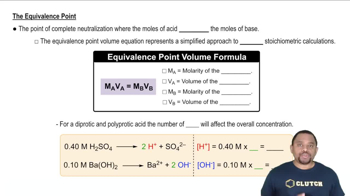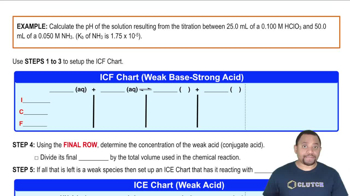Here are the essential concepts you must grasp in order to answer the question correctly.
Titration and Equivalence Point
Titration is a quantitative analytical method used to determine the concentration of a solution by reacting it with a solution of known concentration. The equivalence point is reached when the amount of titrant added is stoichiometrically equivalent to the amount of substance in the sample. In this case, it occurs when all the formic acid (HCO2H) has reacted with the sodium hydroxide (NaOH).
Recommended video:
Equivalence Point in Titration
Stoichiometry of Acid-Base Reactions
Stoichiometry involves the calculation of reactants and products in chemical reactions. For the titration of HCO2H with NaOH, the balanced equation shows a 1:1 molar ratio, meaning one mole of formic acid reacts with one mole of sodium hydroxide. This relationship is crucial for determining the volume of NaOH needed to reach the equivalence point.
Recommended video:
pH Calculation at the Equivalence Point
At the equivalence point of a titration involving a weak acid and a strong base, the resulting solution contains the conjugate base of the weak acid. The pH at this point can be calculated using the concentration of the conjugate base and its hydrolysis in water. This involves determining the Kb of the conjugate base and applying the formula for pH based on the concentration of hydroxide ions produced.
Recommended video:
pH at the Equivalence Point Example




